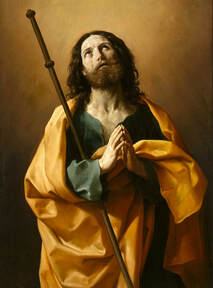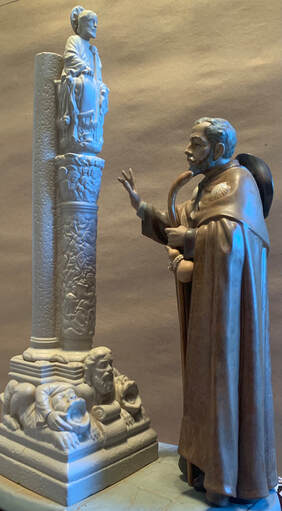
The Life and Martyrdom of St. James the Greater
by Julio Gonzalez, M.D., J.D. Despite being often mentioned in the Bible, being one of the three closest apostles to Jesus Christ, and being the only Apostle whose martyrdom is documented in the New Testament, James the Greater is a most mysterious figure. As we discussed in our overview of the lives of the apostles, James was the son of Zebedee and Salome, a couple of apparent high standing in the region of Galilee. It is thought that Zebedee was a fisherman in either Bethsaida or Capernaum, both areas where John the Baptist preached and sought out his own disciples. Salome was likely the sister of the Blessed Virgin Mary making James the Greater and his brother, John the Apostle, our Lord's first cousins. One more interesting tidbit, in every reference to the two brothers except one, James's name appears before John, making it likely that he was the older of the two men. St. James the Greater in the Bible James entered his apostleship when called by our Lord while mending nets with his brother in their father's boat. (Matt 4:18-22; Mk 1:16-20; Lk 5: 1-11) Along with Simon and Andrew, the two brothers left their jobs and became fishers of men. It appears that both James and John had impassioned hearts, as they were collectively named "Boarnerges" by Jesus, or Sons of Thunder. (Mk 3:17) Once, when Jesus was preparing to enter Jerusalem, the apostles went ahead of him to prepare a reception there. Apparently, the Samaritans in a village en route to Jerusalem refused to welcome Our Lord. James and John, in their anger, asked Jesus, "Lord, do you want us to call down fire from heaven to consume them?" Jesus rebuked them. (Lk 9: 54) On another occasion, it was Salome who demonstrated her misplaced zeal in asking the Lord to arrange for each of her sons to sit at his side in His Kingdom. The Sons of Thunder joined in her plea. But the request prompted Jesus to tell her she was asking for something that was not His to arrange, but for the Father. (Matt 20: 20-24). The exchange shed further insight regarding the priorities of the Lord when the ten other apostles rebuked the two brothers for having made their request. Jesus, appearing to admonish all of them over their arrogance explained that whoever wanted to be the first amongst the apostles needed to be the slave. Jesus continued, "Just so, the Son of Man did not come to be served but to serve and to give his life as a ransom for many," an obvious foreshadowing of the suffering that was to befall our Savior. Despite their seemingly hot tempers and arrogance, our Lord held James and John in high esteem. For example, only James, John, and Peter were invited to witness the transfiguration. The event was amongst the holiest of Jesus's time in the flesh. It took place at a mountain top, and His divinity was so radiant that it shone through Him causing His clothing to turn white as snow and His face to shine as the Sun. Not only did the transfiguration serve to emphasize Jesus's divinity through His physical, glorious, and miraculous brilliance, but with the appearance of Moses and Elias at the mountain, with whom Jesus spoke, the point was made that the old law was submitting to the new. The point was apparently lost on Peter who asked, "Lord, it is good that we are here. If you wish, I will maker three tents here, one for you, one for Moses, and one for Elijah." (Mw 17: 4). This time, the rebuke came from God the Father who appeared in a cloud and said, "This is my beloved Son, with whom I am well pleased; listen to him." (Mw 17: 5). On the way back from the mountain Jesus charged the three men with the responsibility of reporting what they had seen, but only after He had been raised from the dead." (Mw 17: 9) Peter, James, and John were also the only three to witness Jesus's agony in the garden at Gethsemane. (Mw 26:37; Mk 14: 33) This moment in Our Lord's life is crucial since it was the moment of the greatest suffering prior to the passion. It also is the point when He announced that the time had arrived for him to be turned over to the authorities. True to form, Peter, James, and John fell asleep while Jesus faced his agony; not once, but thrice. St. James's Post-Biblical Activities After the Resurrection and Assumption, James the Greater spent a great deal of time preaching the gospel ("the good news") in Jerusalem. Tradition holds that he eventually traveled to the Iberian Peninsula to evangelize Spain. Legend holds that while there, he was approached by an apparition of the Virgin Mary at the Ebro River at Caesaragusta, compelling him to return to Jerusalem for her Assumption. Dutifully, James returned to Jerusalem where all the apostles gathered and did indeed witness the Assumption of the Blessed Virgin Mary. The Assumption took place during the reign of Herod of Agrippa. It is here where we catch up with James the Greater for the last time. According to Acts of the Apostles, Herod beheaded James in 44 A.D. with his own sword. (Acts 12: 1-2) Seeing that this was pleasing to the Jews, Herod then arrested Peter hoping to have him decapitated as well following Passover. The plan was famously foiled, as related in Acts, through the appearance of an angel of the Lord who rescued Peter. There are a few important developments relating to St. James's martyrdom that must be recounted. First, the ancient tradition is that James's body was placed aboard a rudderless boat by two of the disciples he had converted in Spain, Theodore and Athanasius. Angels led the boat to a city in Galicia named Pedrón where he was buried. Second, there are more details about St. James's trial and beheading in the History of the Church by the Eusebius, the fourth century Christian historian. Eusebius takes the story from the Seventh Book of the Hypotyposes, written by Clement of Caesarea. Tragically, Clement's book was last seen in the 9th century, leaving Eusebius's summary as the only documentation of the events that transpired. According to Eusebius, James was brought to Herod by a witness who tradition identifies as Josiah. Upon hearing St. James speak of the faith, Josiah himself converted. Stricken with guilt, Josiah apologized profusely to the Apostle. St. James forgave him, kissed him, and said, "Peace be with you." Upon hearing of the witness's conversion, Herod beheaded Josiah as well such that he and James were beheaded concurrently. (Eusebius, History of the Church, Bk II, Ch. 9.) James's and Josiah's executions took place in Jerusalem's Armenian Quarter where the Armenian Apostolic Cathedral of St. James presently stands. His head is kept under the altar. Finally, Acts, Eusebius, and Josephus, the contemporaneous Jewish historian, each relate Herod's miserable, painful, and rotten death, and Eusebius links it the despicable actions Herod took against James and Peter. Once again, Eusebius relies heavily on his predecessor's lost text and describes an excruciating death characterized by a gastrointestinal ailment that took five days to run its course when Herod was a mere 54 years old. (Eusebius, History of the Church, Bk II, Ch. 10.) The Legacy of St. James James the Greater's story does not end with his beheading nor even with his body's transport to Galicia in Spain. In 815, Pelayo, a Galician hermit had a vision of a pillar of lights, signaling the location of St. James's relics in an abandoned Roman mausoleum. There were so many lights pointing the way to the field that it became known as the field of stars, or "campo de estrellas" or, as it is known today, "Compostela." The story is first related in the Historia Compostelana by Bishop Diego Gelmirez (1069-1140). It was Gelmirez who began the construction of a cathedral to house the relics, which today is known as La Catedral de Santiago de Compostela. After Rome and Jerusalem, La Catedral the Santiago de Compostela is the most often visited holy site. The Cathedral signals the final destination of the Way of St James, a series of roads beginning in numerous locations throughout France, crossing over the Pyrenees, and ending in Santiago de Compostela. The popularity of The Way of St. James owes much to the mediaval Muslim occupation of Jerusalem, as it left no better option for contemporary Christians in Western Europe through which to make a pilgrimage to a holy site. Today, The Way of St. James's popularity is bolstered by the declaration of Pope Calixtus II (1065-1124) statimg that anyone making the journey in a Holy Year, defined as one where July 25 falls on a Sunday, will have his sins forgiven.
The scallop shells have also taken various possible significances. They represent the pilgrims, as they were worn around their necks to collect food along the Way. With their converging lines, the shells also represent the many Caminos of Santiago descending upon Compostela. The scallop shells are so inculcated in the Compostela story that they were even referenced in a poem by Sir Walter Raleigh:
Next week, we will visit James's brother, John the Apostle.
If you have enjoyed reading our Christian Series article, please consider making a donation to The Federalist Pages by cliking on the button below.
Your support will go a long way to help us continue to produce quality content such as this.
Dr. Julio Gonzalez is an orthopaedic surgeon and lawyer living in Venice, Florida. He served in the Florida House of Representatives. He is the author of numerous books including The Federalist Pages, The Case for Free Market Healthcare, and Coronalessons. He is available for appearances and book signings, and can be reached through www.thefederalistpages.com.
0 Comments
Leave a Reply. |
Details
AuthorWrite something about yourself. No need to be fancy, just an overview. Archives
July 2021
Categories
All
|


 RSS Feed
RSS Feed